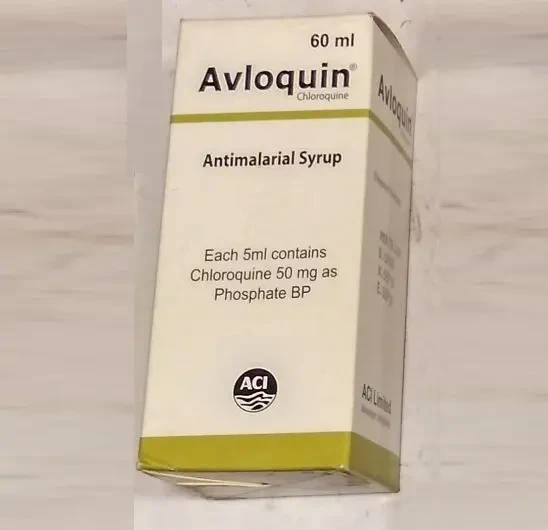60 ml bottle:
৳ 14.91
Also available as:
Indications
Avloquin is indicated in the following cases:
- Treatment of malaria
- Prophylaxis and suppression of malaria
- Treatment of amoebic hepatitis and abscess
- Treatment of discoid and systemic and systemic lupus erythematosus
- Treatment of rheumatoid arthritis
Composition
Tablet: Each film coated tablet contains Chloroquine Phosphate BP 250 mg equiv. to approx. 150 mg of Chloroquine base.
Syrup: Each 5 mL contains Chloroquine Phosphate BP 80 mg equiv. to approx. 50 mg of Chloroquine base.
Syrup: Each 5 mL contains Chloroquine Phosphate BP 80 mg equiv. to approx. 50 mg of Chloroquine base.
Pharmacology
Chloroquine Phosphate is a 4-aminoquinoline antimalarial and amoebicidal agent used for the suppression and clinical cure of malaria due to susceptible strains of Plasmodium falciparum, P. ovale, P. vivax and P. malariae. It is a rapidly acting blood schizontocide with some gametocytocidal activity. Its mechanism of action against blood schizonts remain unclear but it may act by influencing haemoglobin digestion by raising intravesicular pH in malaria parasite cells. It also inferferes with synthesis of nucleoproteins by the parasite. Chloroquine is rapidly and almost completely absorbed from the gastro-intestinal tract when given by mouth. Absorption is also rapid following intramuscular or subcutaneous administration. About 55% of chloroquine in the circulation is bound to plasma proteins.
Dosage & Administration
Doses are normally expressed in terms of chloroquine base, and as a general guide chloroquine base 300 mg is approximately equivalent to chloroquine phosphate 500 mg.
For the treatment of acute attack of malaria:
For the treatment of acute attack of malaria:
- Adults and children: 25 mg of chloroquine base per kg body-weight given over 3 days. This total dose is given in a variety of ways. One way is to give 10 mg per kg followed after 6 to 8 hours by 5 mg per kg, then 5 mg per kg daily for the next 2 days; alternatively, 10 mg per kg may be given daily for the first 2 days and 5 mg per kg on the 3rd day. Sometimes the adult doses are not expressed in terms of body weight but as 600 mg followed after 6 to 8 hours by 300 mg, then 300 mg daily for the next 2 days.
- Adult: An oral dose equivalent to 300 mg chloroquine base is given every 7 days for about one week before, during, and for at least 4 weeks after exposure.
- Children: A weekly oral dose of 5 mg per kg body-weight has been recommended.
- 600 mg base daily for two days, followed by 300 mg base daily for at least 2-3 weeks. Treatment is usually combined with an effective intestinal amoebicide.
- For discoid and systemic lupus erythematosus: Suggested oral dose is 150 mg of base daily, reducing gradually once symptoms have been controlled.
- Adult: 150 mg of base daily, some clinicians suggest that treatment should be given for only 10 months in each year.
- Children: 3 mg/kg body-weight base daily.
- Adult: 150 to 300 mg of base daily during periods of intense light exposure.
- Children: 3 mg/kg body-weight
- Adult: When chloroquine was first used at this condition at doses of 150 mg to 600 mg of base per day for 4-7 days, a severe life threatening toxic hepatitis developed. Use of low dose therapy with 75 mg of base 2 to 3 times per week for 6 to 18 months can avoid such effects and lead to remission.
Interaction
Avloquin exhibits interaction with the drugs like neostigmine, pyridostigmine, antacids, kaolin, cimetidine, ranitidine, quinine, mefloquine, amodiaquine, artemisinin, metronidazole, ampicillin.
Contraindications
- Known or suspected chloroquine resistance in P. falciparum.
- Hypersensitivity.
- Retinal damage.
- Concurrent therapy with hepatotoxic drugs.
Side Effects
Gastro-intestinal: Nausea, vomiting and diarrhoea, Psychological: Psychotic episodes, anxiety and
personality changes.
Visual disturbances: Blurred vision and difficulties in focusing, keratopathy, retinopathy.
Haematological: Aplastic anaemia, agranulocytosis, thrombocytopenia and neutropenia.
Others: Loss of hair, bleaching of hair pigment, bluish black pigmentation of the mucous membranes and skin, photosensitivity, tinnitus, reduced hearing, nerve deafness, uromyopathy and myopathy.
personality changes.
Visual disturbances: Blurred vision and difficulties in focusing, keratopathy, retinopathy.
Haematological: Aplastic anaemia, agranulocytosis, thrombocytopenia and neutropenia.
Others: Loss of hair, bleaching of hair pigment, bluish black pigmentation of the mucous membranes and skin, photosensitivity, tinnitus, reduced hearing, nerve deafness, uromyopathy and myopathy.
Pregnancy & Lactation
The use of chloroquine during pregnancy should be avoided except in the suppression or treatment of
malaria when in the judgement of the physician the benefit outweighs the possible hazard. Because of the potential for serious adverse reactions in nursing infants from chloroquine, a decision should be made whether to discontinue nursing or to discontinue the drug taking into account the importance of the drug to the mother.
malaria when in the judgement of the physician the benefit outweighs the possible hazard. Because of the potential for serious adverse reactions in nursing infants from chloroquine, a decision should be made whether to discontinue nursing or to discontinue the drug taking into account the importance of the drug to the mother.
Precautions & Warnings
- The eyes should be examined before starting long-term treatment and should be monitored subsequently.
- Visual disturbances may render patients unfit to take charge of vehicles or machinery.
- Care is necessary in administering to patients with impaired liver or renal function or to those with prophyria, psoriasis, or a history of epilepsy.
- Patients with glucose-6-phosphate dehydrogenase (G6PD) deficiency should be observed for haemolytic anaemia during chloroquine treatment.
Therapeutic Class
Anti-malarial drugs
Storage Conditions
Keep below 30°C temperature, away from light & moisture. Keep out of the reach of children.


